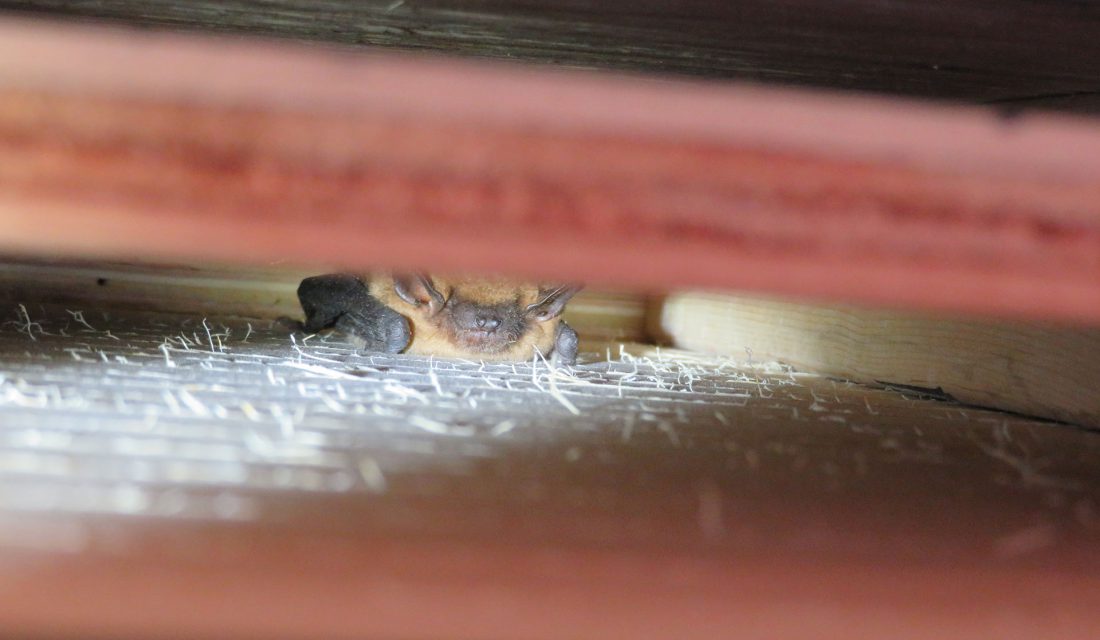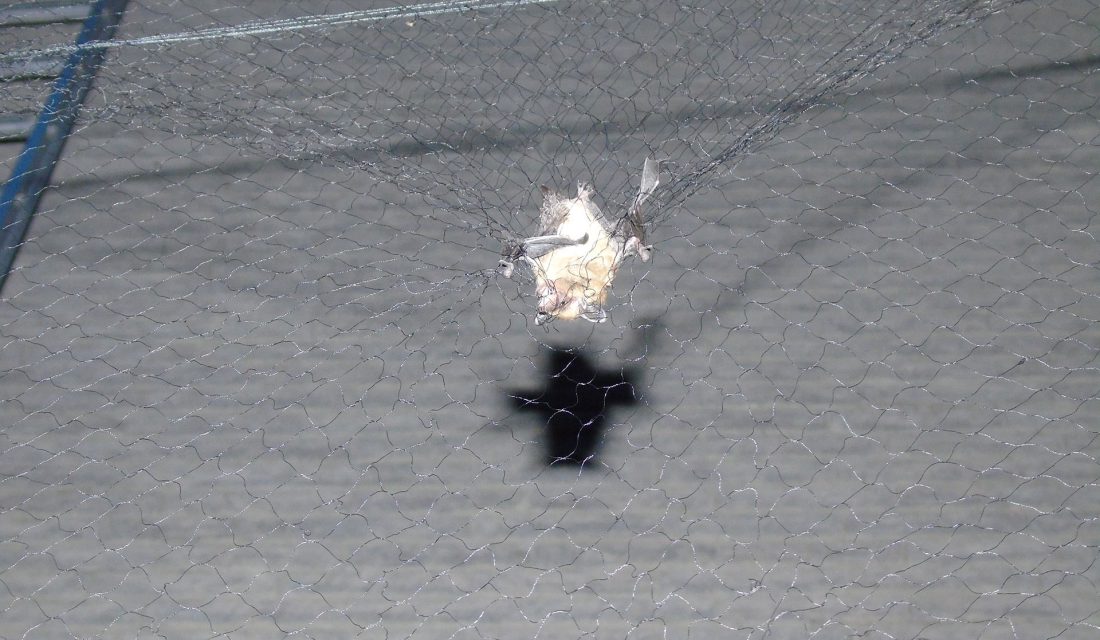It’s 8:30 p.m. when we arrive at a quiet home in the quaint town of Manotick, Ontario, south of Ottawa. But it won’t stay quiet for long.
As the sun begins to set, we have little time to waste as we set up for our evening stakeout, which will include a display of silhouettes cast by secretive creatures venturing into the night sky. Four of us are stationed at strategic points around the house – Mike (CWF’s Bat Specialist – contract), Samantha (CWF’s Summer Bat Intern), two participants of the CWF Conservation Corps program (Mac and Chris) and myself, James (CWF’s Species at Risk and Biodiversity Specialist).
As the sun slowly sinks and the sky darkens, we begin to hear movement high up under the eaves of the home, and then one silhouette after another swoops out of a gap no wider than a loonie – we count 105 in total. Bats have taken up residence in the attic, and they have emerged for their evening foraging. Each bat will eat over 6,000 insects every night, including the mosquitoes we have been incessantly swatting since our arrival.
Our goal is to figure out which species of bat is present and how many bats live in the home. This will help us prepare for our upcoming study, which will be one of only a handful of studies into the interaction between bats, humans and habitat loss.
Tech to Track Bats
![]()
Armed with our acoustic monitoring device, we are able to detect the bats. Bats use echolocation – an amazing ability developed over millions of years that allows them to locate objects using reflected sound. Our acoustic monitoring device lets us hear what bats are hearing when they echolocate.
The chatter on our device begins, and the sound is plotted on a graph that we can use to determine the species of bat – each species has its own unique frequency and length of call. In this case, we have found all Big Brown Bats — not the endangered Little Brown Myotis, which we were hoping to find for our study. This isn’t surprising to us since colonies of Little Brown Bats are becoming few and far between.
We are still excited for the next step in our study, which involves installing large nets to catch as many of these bats as possible to outfit them with radio transmitters and track where they go.
Evicting Bats From Houses

While many homeowners are comfortable sharing their attic, soffit or chimney with a few bats, some homeowners are less inclined. Unlike mice, bats don’t chew wires. Also, many bat colonies number in the dozens (not hundreds) so they don’t produce much guano (bat poop). However, even the guano of bats can be useful if you lay down a drop sheet and use the poop as fertilizer.
“I don’t want them gone — I’d just prefer them not in my house,” says our homeowner. “They do help with the mosquitoes.” Indeed, a 2009 study found a 32 per cent reduction in mosquito egg-laying when bats were present.
The homeowner had contacted Get ’Em Out Wildlife Control — a bat-friendly company. They were hired to carry out an exclusion, which involves installing a one-way door so that bats can leave but can’t get back in. The eviction will take place a few days into the study so that we can get a sense of what the bats do before and after the eviction.
Research Opportunity
The CWF team is using this opportunity to investigate what happens to bats when they are humanely removed from a home. We are asking the following questions:
- Do the bats adapt?
- Do the bats move to another roost site?
- Do the bats die?
To answer these questions, we are going to track the bats for a few days to determine their normal behaviour and then see what happens after the exclusion when they can’t get back into the house.
Next Step: Capture Night
Tonight is capture night, which means we’re back at the house. This time we’re here with several volunteers, including participants in the Canadian Conservation Corps and Derek Morningstar, the bat expert who is leading the capture and tagging.
Our work has caught the attention of CTV News, so we start setting up the nets in front of the bats’ exit sites while reporters capture video and interviews. Once again, activity starts as the sun sets on the horizon.

Each bat is weighed, measured and inspected for signs of White-nose Syndrome. Thankfully, there are no signs of the disease, which is less common in this species compared to three of Canada’s endangered bat species: the Little Brown Bat, the Tri-colored Bat and the Northern Long-eared bat.
We place an armband – each with a unique code – on each of the bats in case any of them are found again. Six lucky individuals are also outfitted with a radio transmitter the size of a watch battery, which is affixed to their back using surgical glue. This will allow us to track the movement of each bat to find out where it goes. The process is harmless and the glue will fall off after about two weeks, which is roughly the time the battery runs out in the transmitter.
One by one, Derek takes each bat into the open backyard to be released. They stretch their wings and swoop out of his gloved hand, and we watch as they get accustomed to their new accessories.
We catch 45 bats by 3:30 a.m. We are tired but elated to have had the chance to see these amazing creatures up close.
The Next Morning
Mike and I meet back at the home the next morning for our first day of tracking. This will be our routine for the next two and a half weeks. With antenna in hand, we set the receiver to the frequency of our first bat, and right away we hear a repetitive pinging sound like a metronome keeping time. Our first bat – an adult female who had given birth this year – has gone back into the attic.
Moving on, we set the receiver to the next tag and wait for the sound. But nothing. The adult male is nowhere within the one-kilometre range that the antenna can pick up. One by one, we go through each of the six bats and discover that all the others are back in the home.
We have our first results – the male didn’t come back, but all the other bats did.
Switching to the rooftop antenna, we hop in the car and circle the area to see if we can pick up our missing bat. We drive for an hour through neighbourhoods, listening to nothing but static coming from the receiver. Finding this bat is like finding a needle in a haystack.
Finally a faint sound comes from the receiver and builds as we drive. We are getting closer to the tag. At its strongest signal, we get out of the car and are able to pinpoint the male – he’s roosting in a century farmhouse nearly 2.5 kilometres from where we caught him last night.
Eviction Day
It’s now eviction day. Mike, Samantha and I have carried out three days of tracking and nothing has changed – the bats are in the same spot we last found them. The exception is the adult male, who has moved again; he’s gone another 500 metres and is now three kilometres from our initial capture site.
Get ’Em Out Wildlife Control is working to install the one-way door, along with one of CWF’s four-chamber bat houses to give the bats a new place to go. This time when the bats leave, they’ll have to find a new home. I suspect some will make use of the bat house, which is installed just next to their exit hole.
Tomorrow will be interesting.
Exclusion: Day 1
It’s day one after the exclusion and we’re locating many of the tags still in the house. This means that either the bats didn’t leave or their tags fell off inside the home.
One bat left the house and we tracked her to a cedar hedge across the road. One of the other tags we simply couldn’t find, despite carrying out a five-kilometre sweep of the area for most of the day.
No bats are in the bat house. I’m wondering what happened to the other 99 bats that we originally counted in the home.
Two weeks after the capture, the tags are starting to fade. The signal is weaker, and we can’t even pick up a signal on two of the tags. All of the bats except one have moved to other houses in the neighbourhood and have mostly stayed put for the entire two weeks. Two of them joined each other in the same new home, but the others struck out on their own, perhaps joining other colonies. All except the adult male are staying within 350 metres of the original site.
The good news is that despite over 100 bats originally being in the home, there are no signs that any remain.
Exception to the Rule
A few weeks later, I receive an email. The homeowner has come across a deceased bat with an armband and a code on it. Unfortunately, this is a bat that we had banded but not tagged for tracking – a juvenile female born just this year. This makes us question whether there is more bat mortality as a result of eviction than we know of.
Could this have been the fate of the two bats we couldn’t relocate? Additional studies and some tweaks to our approach are needed to answer these questions.
As for the bat house, it wasn’t used by any bats during the study period. But when we check again at the end of October, two bats are roosting in the house. At least one of the bats is sporting our armband – we can’t tell whether the other one is. The bats just needed some time to get used to the bat house being there. Checking back in mid-November, the two bats have moved on from the bat house, likely to a warmer overwintering site, but we have no idea where that might be since the bats won’t have been able to get back into their original attic roost.
We have received reports of our bat houses being used at other homes, so we are currently compiling the information in a separate study to determine the most effective bat house design. If you have a bat house of any design, you can help by following our Monitoring Your Bat House guide and reporting your findings through our Help The Bats Project on iNaturalist.ca. If you don’t have a bat house yet, we have instructions for building one at HelpTheBats.ca, and we have some for sale in our online store.




